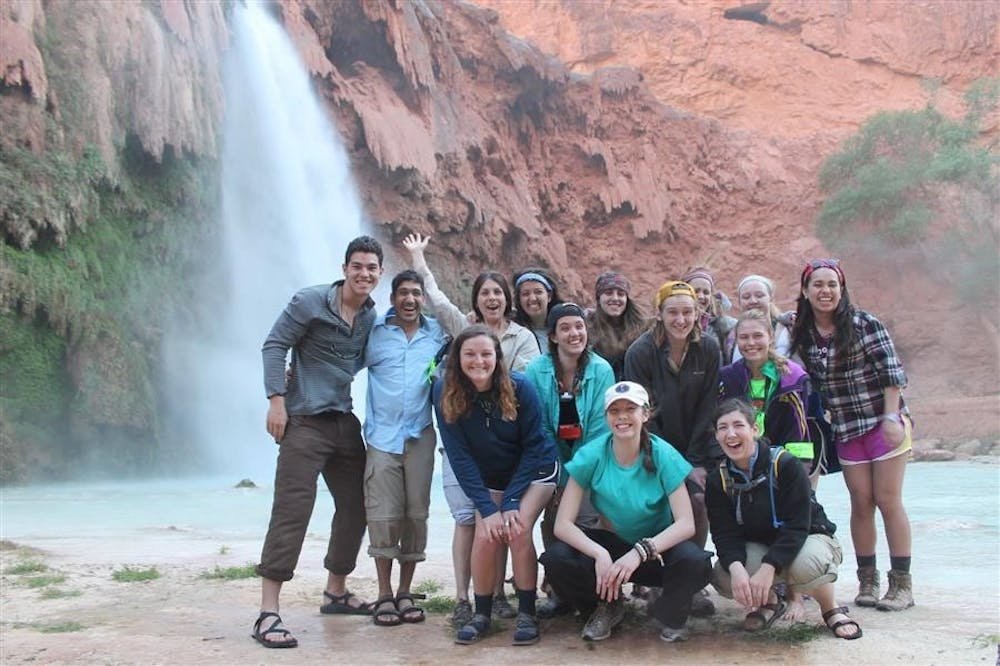IU Outdoor Adventures sent seven groups to explore different areas of the country and experience the outdoors during spring break.
For these trips, each group practiced Leave No Trace principles, which mean leaving the area the way it was found.
Two groups were sent to backpack in Grand Canyon National Park. The groups went on separate trips to the same location.
“We tried a new trail, about 40 miles of backpacking,” said senior Meredith Strunk, IUOA outreach coordinator and trip leader.
Toward the end of one day while they were backpacking, Strunk said her group approached a tall canyon with walls reaching about 300 feet. She said her group was at the mouth of the slot canyon when they realized they had lost the trail.
“Since it’s all stone, it’s not like you can really see the trail,” she said.
She said they looked down and realized they’d have to climb into the canyon. Taking off their backpacks, they helped one another navigate around boulders.
“We looked straight up, and on both sides of us were these beautiful stone cliffs,” Strunk said. “It was really cool to feel that small and to be able to see a very little part of the sky.”
Senior Trip Leader Greg Welage, along with two other IUOA groups, went rock climbing in the Rocky Mountains.
“We walked from our campground each morning to the climbing sites within Shelf Road,” Welage said. “It contains about 1,000 bolted routes.”
Strunk said spring rock climbing trips normally experience cold weather, making it difficult to climb because the participants’ hands are cold. This year, the weather was warm for the climbers.
“In the middle of the week we were climbing in snow flurries and woke up to about one inch of snow the next morning,” Welage said. “But the next day was sunny with a high temperature in the 60s.”
Many of the climbers on the trip were new to climbing, Strunk said. Welage and the other leaders taught the climbers technical skills each day.
“I think what’s cool about OA trips is that people can not have experience in things, even as technical as rock climbing,” she said.
In Marathon, Texas, senior Brian Fitzgerald and junior Catherine Krege canoed 84 miles in six days along the Rio Grande River.
“It was really calming,” Krege said. “I thought it was a really relaxing spring break.”
There was no civilization in the area, which allowed for special sight-seeing, Fitzgerald said.
“There’s literally nothing around for miles, either on the Texas side or the Mexican side,” Fitzgerald said. “There’s no light pollution.”
He said being able to see all the stars at night was an unusual experience.
The groups canoed 12 to 24 miles a day, he said. Then they would stop, set up camp and stay in that location for the night, also practicing Leave No Trace camping.
“Another thing with Leave No Trace and back country camping, which is camping without a campsite, is there is no electricity and you cannot shower,” Krege said.
She said they would carry all their waste with them — a small sacrifice to save the beauty of the area.
“The shower part didn’t affect me as much as our other participants,” Fitzgerald said. “What’s great about our trip is it’s a water trip, so we can scrub off some of the dirt, and halfway through our trip we stopped at a hot spring.”
Krege said the group swam in the beautiful hot spring.
Fitzgerald said it was rejuvenating, and he never felt cleaner.
“It’s so good to kind of let go of everything, including all of your worries,” Fitzgerald said. “You’re basically focused on miles and food.”
Junior Christopher Sajdak participated in the Havasu Falls backpacking trip. The group drove 30 hours to its final destination, where they hiked eight miles to an Indian reservation.
The reservation is located near a water fall in the Colorado River in the Grand Canyon area, where they stayed for three days.
“We stayed at the Havasupai Village, and it’s the most remote village in the lower 38,” he said, “and the only way to get there is by helicopter or take the eight-mile hike.”
They swam and soaked up the sun, Sajdak said. The group also learned about life on the reservation.
“It’s amazing to see how all the people are fully sustained by tourism and people staying at the campsites there,” he said. “And without the tourism, they would be completely isolated.”
Along the hike, Sajdak said there are two 55-foot waterfalls, and the campground is at the bottom of a 66-foot waterfall.
“It was the most beautiful place I’ve ever gone to,” Sajdak said. “It’s truly an oasis in the middle of the Grand Canyon.”
Follow reporter Allison Wagner on Twitter @allmwagn.
IUOA sends seven groups to explore U.S.

Get stories like this in your inbox
Subscribe


